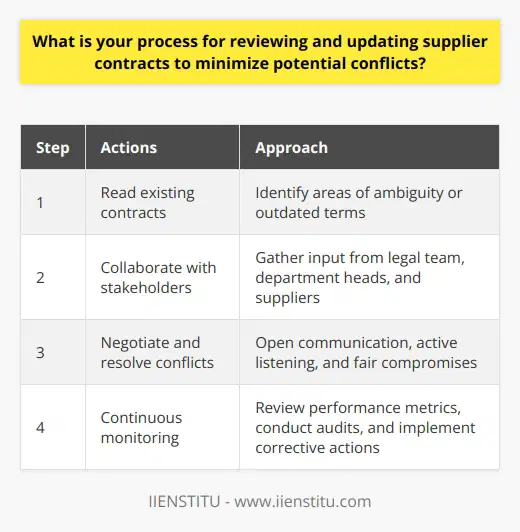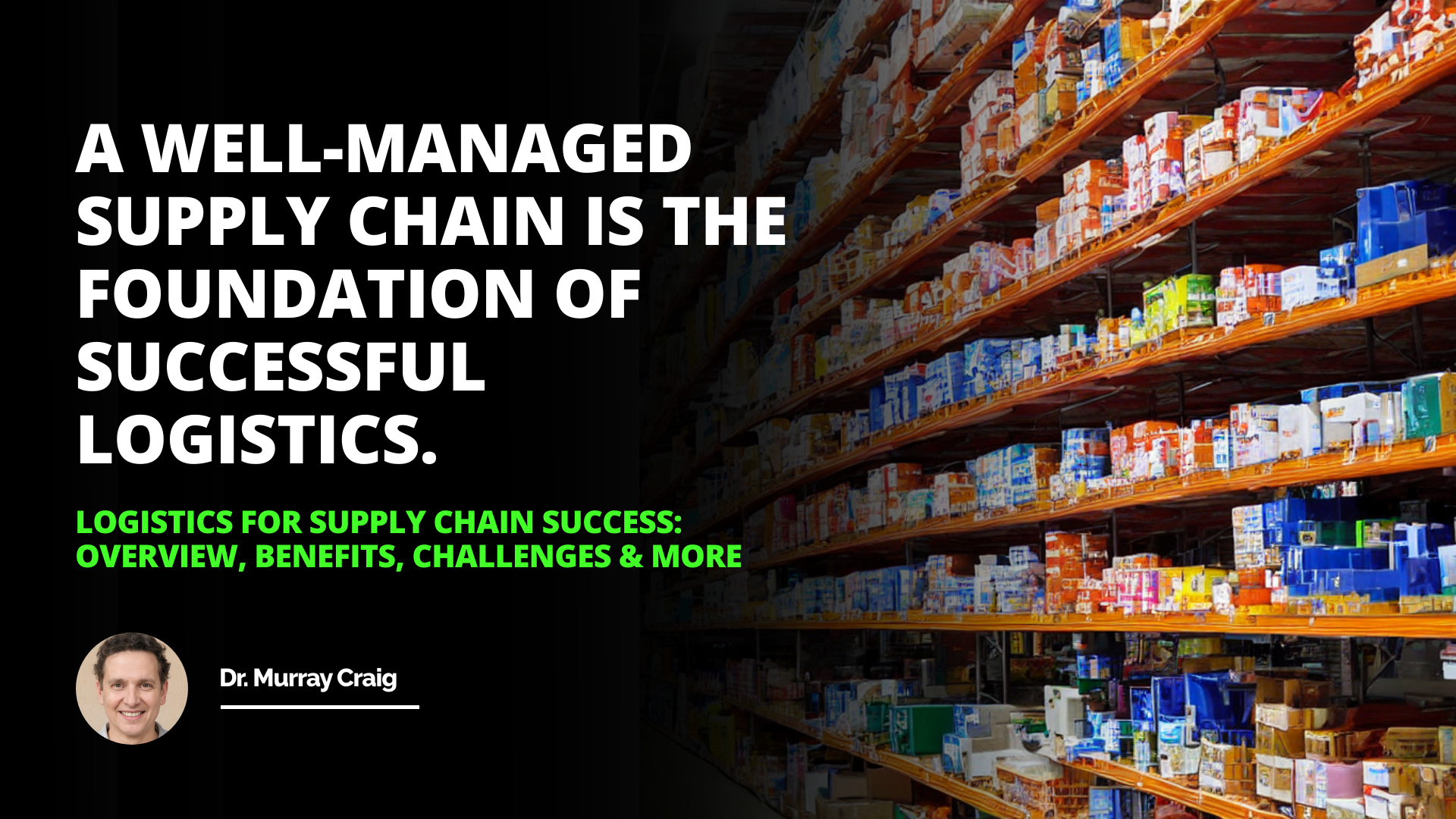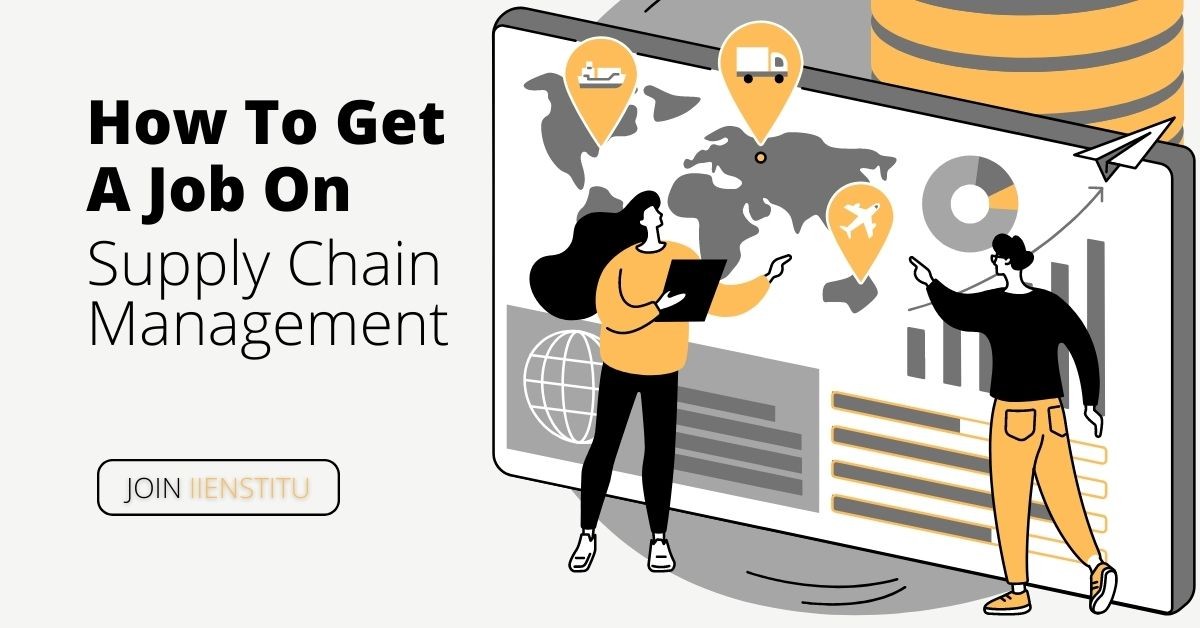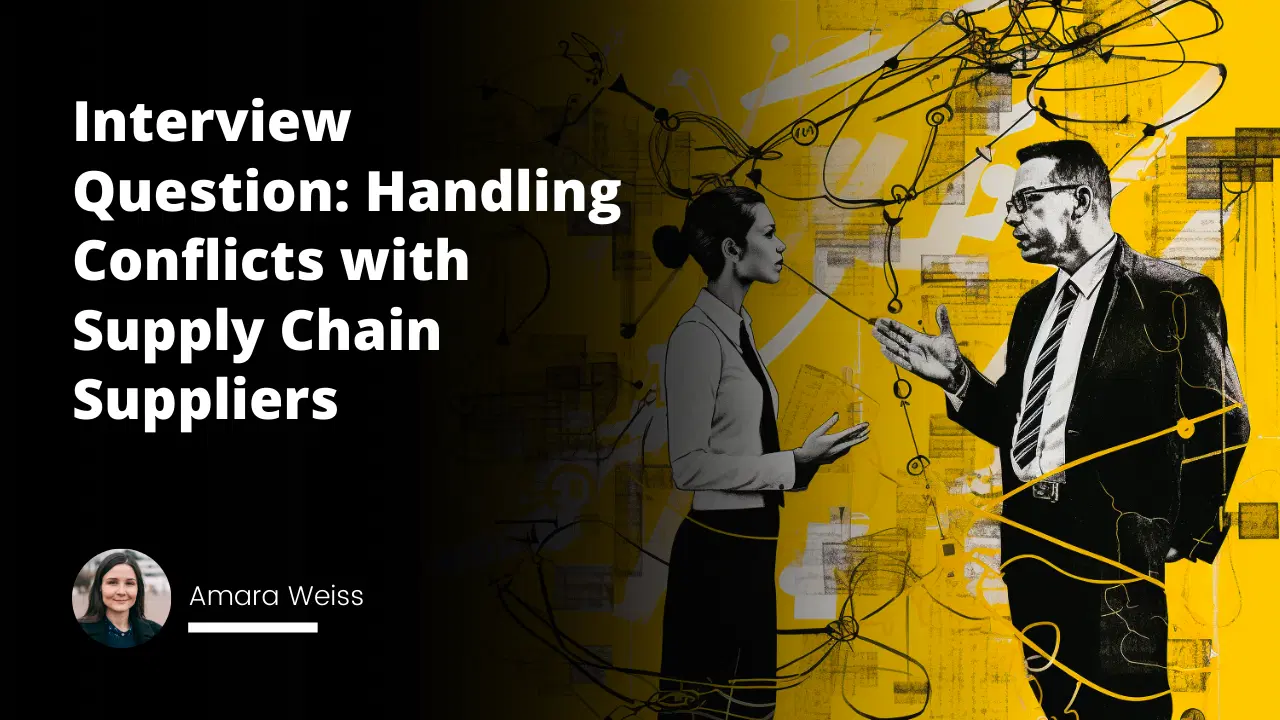
Any business venturing into the realm of supply chain management is likely to face its share of roadblocks and hurdles. One such pressing issue prevalent in this domain is handling conflicts with supply chain suppliers.
Several companies grapple with these conflicts, as it directly impacts their productivity, brand image, and bottom line. So, how should a company approach these whirlwinds of unrest? Let's dive into the matter.
Why is this interview question asked: How do you plan to handle conflicts with supply chain suppliers?
When recruiters pose the question, "How do you plan to handle conflicts with supply chain suppliers?" during an interview, they're attempting to evaluate your problem-solving skills, communication abilities, and the depth of your knowledge about the supply chain management.
It is crucial to keep in mind that this question isn't just about conflicts; it's largely about your ability to navigate through them, maintaining optimal operational efficiency.
The purpose of the question
By asking this question, interviewers intend to assess your understanding of the supply chain dynamics and the complications that can arise in these relationships.
They want to infer whether you're capable enough to strategize responses, negotiate, communicate effectively, and maintain business ethics in troubled waters. It's about gauging your tactfulness, diplomatic acumen, and leadership abilities in managing conflicts and disputes.
Related Course: Online Leadership Course
At what interview level is it asked?
This question is generally asked at the managerial or decision-making level interviews in industries where supply chain management plays a significant role. Industries such as retail, e-commerce, manufacturing, logistics, and others dealing with multiple suppliers regularly are interested in knowing your strategy for handling conflicts with supply chain suppliers. Even for intermediate levels with a high degree of supplier interaction, this question might crop up during interviews.
What kind of answer is expected from the candidate?
An ideal answer should reflect your understanding of the complex world of supply chain operations and capacity to analyze conflicts from various angles.
It should display your aptitude to resolve disputes amicably and professionally without hampering the efficiency of operations. Candidates should show their ability to remain calm, composed, and solution-focused when dealing with such conflicts. Additionally, showcasing previous experiences handling conflicts with supply chain suppliers can provide some substance to your answer.
Possible answers to consider
Remember, there is no one-size-fits-all response to this question. However, to help you shape your answer, consider the following pointers:
Prioritize Open Communication: Your answer should underline the importance of open, transparent, and frequent communication with suppliers to prevent misunderstandings and conflicts.
Adopt Fair Business Practices: Include that practicing ethical business conduct while dealing with suppliers can build trust and reduce conflict chances.
Foster Long-term Relationships: Articulate how maintaining a long-term relationship with suppliers can positively impact reducing conflicts.
Act Swiftly: Emphasize on acting promptly and swiftly before the conflict snowballs into an irrevocable situation affecting the supply chain operations.
Utilize Third-Party Mediation: In case of intractable conflicts, your willingness to involve neutral parties for conflict resolution can also be beneficial.
Before you answer this question, it is vital to understand the context of the interview and the specific role you are being considered for. An encapsulating view of this matter will help you tailor an effective response to handle conflicts with supply chain suppliers, and rest assured, it will suitably impress your recruiters.
Conflict Resolution Strategies with Supply Chain Suppliers
Types and Causes of Conflicts with Supply Chain Suppliers
Impact and Outcome of Conflicts with Supply Chain Suppliers
Similar interview questions:
How do you manage disagreements with supply chain suppliers?
What strategies do you use to resolve conflict with supply chain suppliers?
Can you elaborate on your method for handling disputes with providers in your supply chain?
What measures do you take to prevent conflict with your supply chain suppliers?
How do you assure smooth relations with your supply chain suppliers amidst disagreements?
What effective steps do you take to resolve supplier disputes in the supply chain?
How do you maintain balance in the supply chain when conflicts with suppliers arise?
What approach do you employ to deal with conflicts with your supply chain partners?
Can you explain your conflict resolution techniques with regards to supply chain suppliers?
How do you navigate issues or conflicts that arise with suppliers in your supply chain?
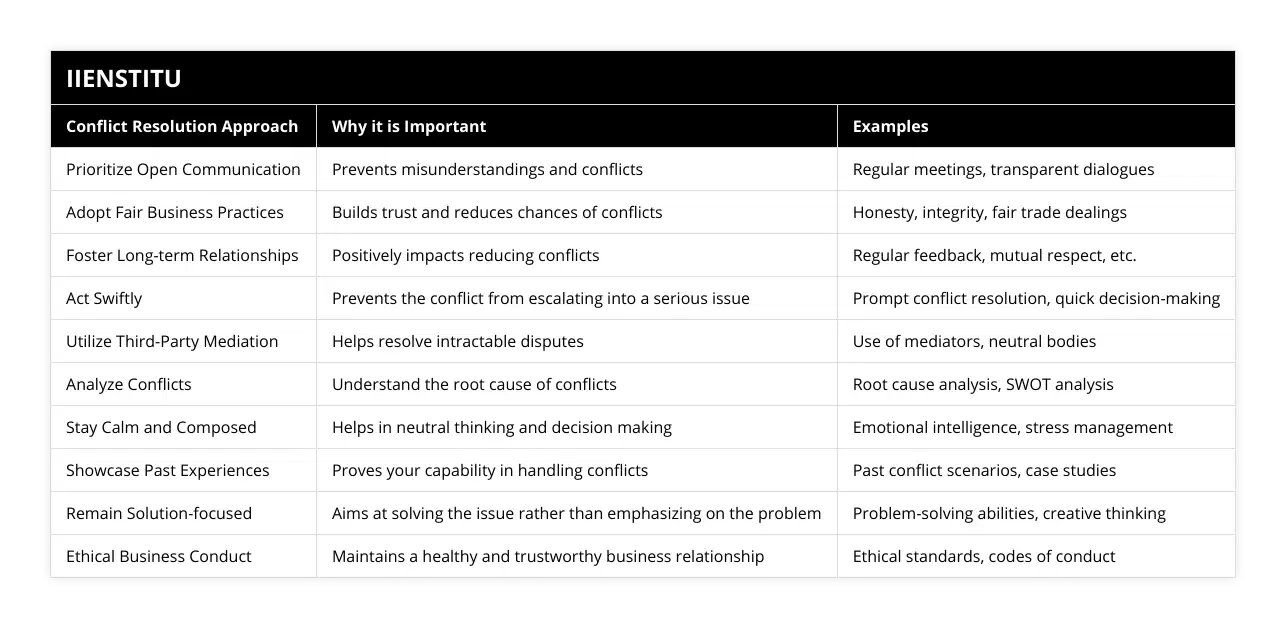
Frequently Asked Questions
How do you approach resolving disputes with vendors?
When resolving disputes with vendors, I always prioritize open communication and active listening. I believe that most conflicts arise due to misunderstandings or unmet expectations, so the first step is to clarify the issue at hand.
Understand the Vendor's Perspective
I make a genuine effort to understand the vendor's perspective. I ask questions to gather more information and try to put myself in their shoes. This helps me identify the root cause of the problem and find common ground.
Propose a Win-Win Solution
Once I have a clear understanding of the situation, I work with the vendor to brainstorm potential solutions. I aim to find a mutually beneficial outcome that addresses both parties' concerns. I'm willing to compromise and negotiate to reach an agreement that works for everyone.
Maintain Professionalism
Throughout the dispute resolution process, I remain calm, composed, and professional. I avoid letting emotions cloud my judgment or lead to hasty decisions. I focus on the facts and maintain a respectful tone, even if the conversation becomes challenging.
Follow Up and Monitor Progress
After reaching a resolution, I follow up with the vendor to ensure that the agreed-upon actions are implemented. I monitor progress and maintain open lines of communication to prevent future misunderstandings. I believe that building strong, long-term relationships with vendors is crucial for success.
In my experience, approaching vendor disputes with empathy, collaboration, and a solutions-oriented mindset yields the best results. It helps preserve valuable partnerships and ensures smooth operations in the long run.
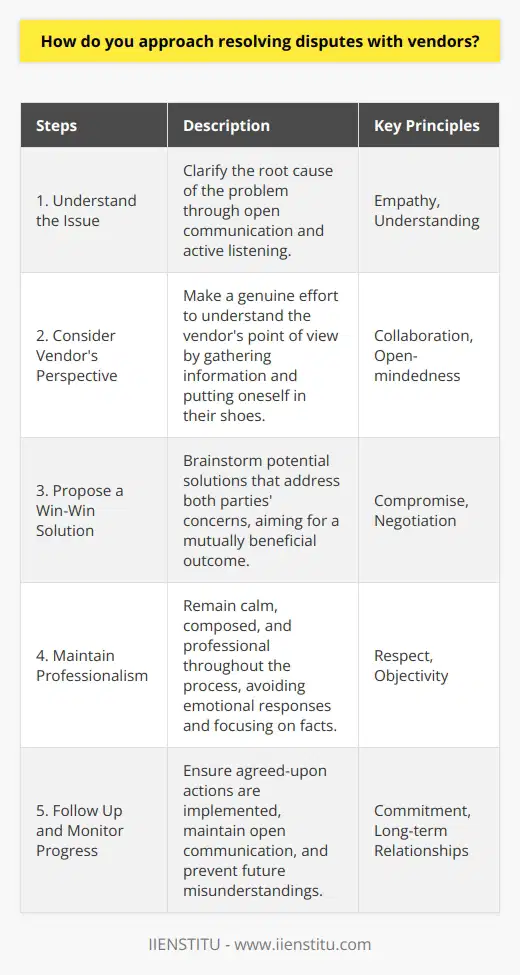
What strategies do you employ to maintain positive relationships with suppliers?
To maintain positive relationships with suppliers, I employ several strategies that have proven effective throughout my career. First and foremost, I prioritize open and honest communication. I make sure to clearly convey our company's needs and expectations while also actively listening to the supplier's concerns and ideas.
Building Trust and Rapport
I believe that building trust and rapport is crucial for long-lasting partnerships. I take the time to get to know our suppliers on a personal level, learning about their business, their challenges, and their goals. By showing genuine interest and empathy, I create a foundation of mutual understanding and respect.
Timely Payments and Fulfilling Commitments
I understand that suppliers rely on timely payments to keep their operations running smoothly. I work closely with our finance department to ensure that invoices are processed promptly and payments are made according to the agreed-upon terms. Additionally, I make sure to fulfill our commitments, whether it's meeting delivery deadlines or providing accurate forecasts, to maintain the supplier's trust in our partnership.
Collaborative Problem-Solving
When issues or challenges arise, I approach them with a collaborative mindset. Instead of placing blame, I work together with the supplier to identify the root cause of the problem and brainstorm solutions. By treating our suppliers as partners and valuing their input, we can overcome obstacles and find mutually beneficial outcomes.
Continuous Improvement and Feedback
I believe in the power of continuous improvement. I regularly seek feedback from our suppliers on how we can strengthen our relationship and streamline our processes. By actively soliciting their input and implementing their suggestions, we can drive efficiency, reduce costs, and enhance the overall quality of our collaboration.
In summary, maintaining positive relationships with suppliers requires a combination of open communication, trust-building, timely fulfillment of commitments, collaborative problem-solving, and a focus on continuous improvement. By prioritizing these strategies, I have successfully fostered long-term, mutually beneficial partnerships that have contributed to the success of our company.
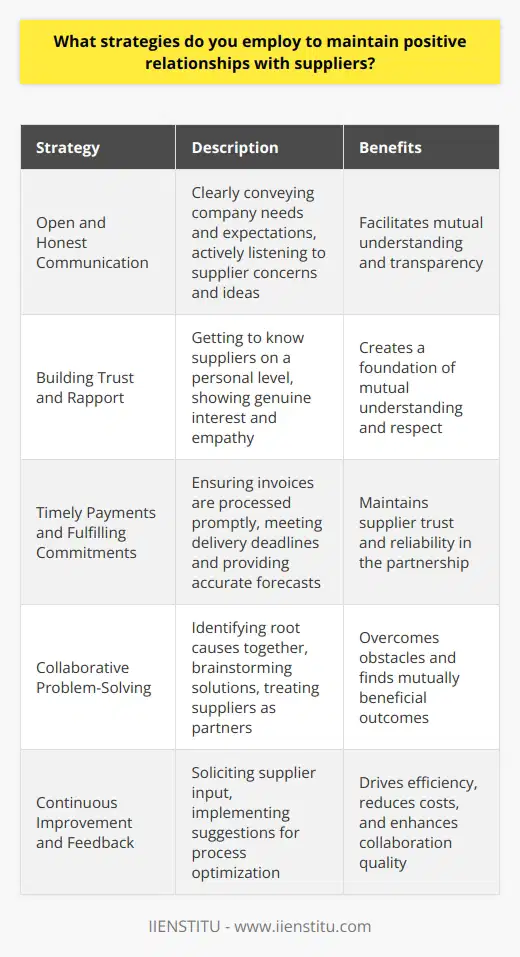
Can you describe a time when you successfully resolved a conflict with a supplier?
In my previous role as a purchasing manager, I encountered a conflict with a key supplier over late deliveries. I scheduled a meeting with the supplier's representative to discuss the issue and find a solution.
Listening to the Supplier's Perspective
During the meeting, I actively listened to the supplier's challenges and reasons behind the delayed shipments. They were experiencing a temporary shortage of raw materials due to unexpected demand.
Collaborating on a Solution
Together, we brainstormed potential solutions that would benefit both parties. I suggested adjusting our order quantities temporarily, while they committed to prioritizing our deliveries and providing regular updates on their production status.
Implementing and Monitoring the Plan
We agreed on a revised delivery schedule and I closely monitored their progress. I maintained open communication with the supplier and addressed any concerns promptly.
Successful Resolution and Strengthened Partnership
Through collaboration and understanding, we successfully resolved the conflict and received our supplies on time. This experience strengthened our partnership and taught me the importance of active listening and working together to find mutually beneficial solutions.
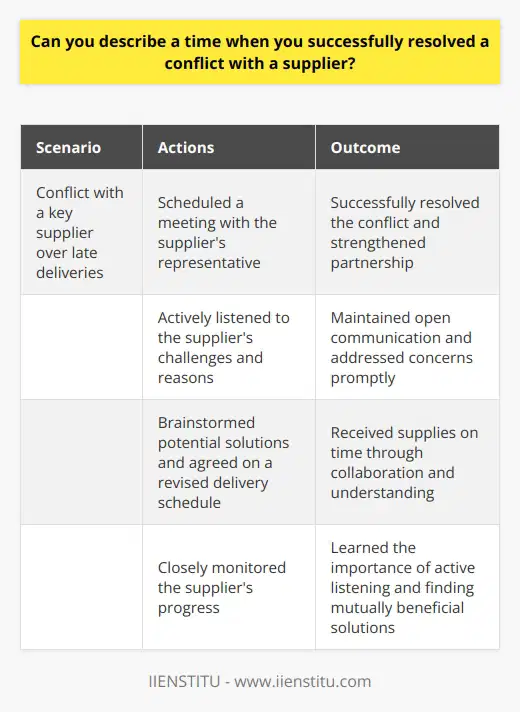
How do you ensure effective communication with supply chain partners?
At my previous company, I implemented several strategies to ensure effective communication with our supply chain partners:
Regular Check-Ins
I scheduled weekly calls with our key suppliers to discuss production status, potential issues, and upcoming orders. These consistent touchpoints helped us stay aligned and address problems early on.
Clear Documentation
I made sure all agreements, specifications, and timelines were thoroughly documented and easily accessible to both parties. Having everything in writing prevented misunderstandings down the line.
Collaborative Planning
Each quarter, I organized face-to-face meetings with our partners to review forecasts, plan for peak periods, and brainstorm process improvements. Working side-by-side strengthened our relationships and generated valuable ideas.
Transparent Information Sharing
I set up a shared portal where we could exchange real-time updates on inventory levels, shipment tracking, and quality metrics. Keeping everyone informed minimized disruptions and delays.
Continuous Feedback
I encouraged open, two-way communication and actively sought input from our suppliers. Their insights helped us refine our ordering patterns and product designs for mutual benefit.
By prioritizing proactive outreach, clear expectations, and joint problem-solving, I was able to build trusting, productive partnerships with our supply chain. These strong lines of communication ultimately improved our reliability, efficiency, and ability to satisfy customers.
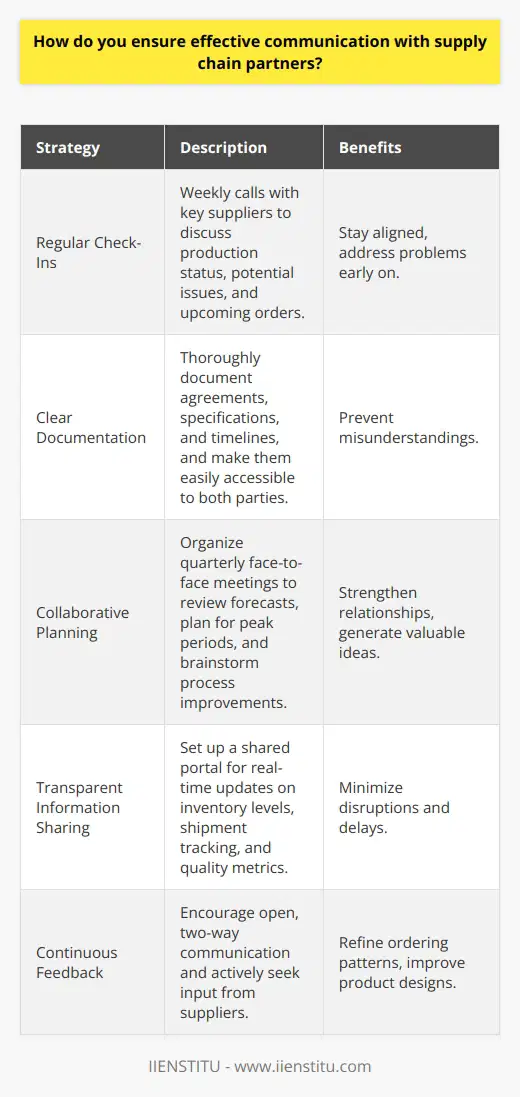
What steps do you take to prevent conflicts with suppliers from escalating?
As a procurement specialist, I understand the importance of maintaining positive relationships with suppliers. Conflicts can arise due to misunderstandings, miscommunication, or unforeseen circumstances, but it's crucial to address them promptly and effectively to prevent escalation.
Establishing Clear Communication Channels
I believe in establishing open and transparent communication channels with suppliers from the start. By setting expectations, defining roles and responsibilities, and agreeing on performance metrics, we create a foundation for a strong partnership. Regular check-ins and progress updates help identify potential issues early on.
Addressing Issues Proactively
When conflicts do arise, I take a proactive approach to resolution. I listen actively to understand the supplier's perspective and concerns. By acknowledging their point of view and showing empathy, I create an environment where we can work together to find a mutually beneficial solution.
Collaborating on Solutions
I believe in collaborating with suppliers to develop creative solutions that address the root cause of the conflict. Whether it's adjusting timelines, renegotiating terms, or finding alternative approaches, I work closely with the supplier to explore options that align with our shared goals and objectives.
Escalating When Necessary
In rare cases where a resolution cannot be reached at my level, I follow a clear escalation process. I involve key stakeholders and decision-makers who can provide guidance and support in finding a resolution. Throughout the process, I maintain professionalism and focus on finding a win-win outcome.
By establishing trust, fostering open communication, and collaborating on solutions, I have successfully prevented conflicts with suppliers from escalating in my previous roles. I believe that investing in strong supplier relationships is key to achieving long-term success in procurement.

How do you handle situations where a supplier fails to meet their contractual obligations?
When a supplier fails to meet their contractual obligations, I take a proactive and solutions-oriented approach. I believe in open communication and collaboration to resolve issues promptly.
Assess the Situation
First, I gather all relevant information about the supplier's failure to fulfill their commitments. I review the contract terms, document the specific breaches, and assess the impact on our business operations.
Communicate with the Supplier
Next, I reach out to the supplier to discuss the situation. I express our concerns firmly but professionally, seeking to understand the reasons behind their non-compliance. Together, we explore potential remedies and establish clear expectations for resolving the issues.
Develop a Resolution Plan
Based on the discussions with the supplier, I work on developing a concrete action plan. This may involve renegotiating timelines, defining compensation for losses, or exploring alternative suppliers if necessary. The goal is to mitigate risks and ensure business continuity.
Monitor Progress and Maintain Records
Throughout the resolution process, I closely monitor the supplier's progress in meeting the agreed-upon commitments. I maintain detailed records of all communications, agreements, and actions taken. This documentation serves as evidence and helps prevent future occurrences.
In my experience, a proactive and collaborative approach often yields the best results when dealing with supplier non-compliance. By communicating clearly, working towards mutually beneficial solutions, and holding suppliers accountable, I have successfully resolved several challenging situations in my career.
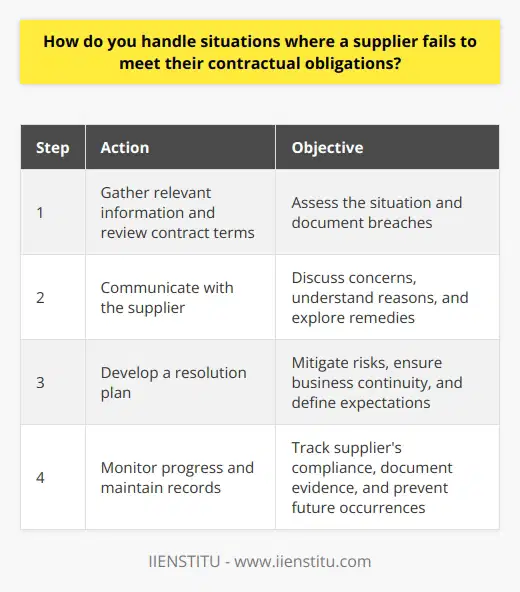
Can you give an example of how you negotiated a resolution to a supply chain dispute?
In my previous role as a supply chain manager, I successfully negotiated a resolution to a critical supplier dispute. The supplier had consistently failed to meet delivery deadlines, causing significant production delays and financial losses for our company.
Identifying the Root Cause
I scheduled a face-to-face meeting with the supplier's management team to discuss the issues at hand. During the meeting, I actively listened to their concerns and challenges, while clearly communicating the impact of their non-performance on our operations.
Through open and honest dialogue, we identified the root cause of the problem: the supplier was understaffed and lacked the necessary resources to meet our production demands.
Developing a Win-Win Solution
Together, we brainstormed potential solutions that would benefit both parties. I proposed a collaborative approach, offering to provide temporary staff and expertise from our company to help the supplier optimize their production processes and increase efficiency.
In exchange, the supplier agreed to prioritize our orders and committed to meeting the revised delivery schedules. We also established clear performance metrics and regular progress reviews to ensure accountability and continuous improvement.
Achieving Positive Results
Through this negotiated resolution, we not only resolved the immediate supply chain disruption but also fostered a stronger, more resilient partnership with the supplier. Our collaborative efforts resulted in improved supplier performance, reduced lead times, and increased overall supply chain reliability.
This experience demonstrated my ability to effectively negotiate win-win solutions, build strong relationships with key stakeholders, and proactively address supply chain challenges to ensure business continuity and success.

What methods do you use to foster collaboration and cooperation among suppliers?
To foster collaboration and cooperation among suppliers, I rely on several key methods. First and foremost, I prioritize open communication. I schedule regular meetings with suppliers to discuss ongoing projects, share updates, and address any concerns. These meetings provide a platform for exchanging ideas and finding solutions together.
Building Strong Relationships
Beyond regular communication, I invest time in building strong relationships with suppliers. I believe that trust and mutual respect are essential for successful collaboration. I make an effort to understand each supplier's unique needs, goals, and challenges. By showing genuine interest and care, I create a foundation for effective partnerships.
Encouraging Teamwork
I actively encourage teamwork among suppliers. When multiple suppliers are involved in a project, I facilitate joint problem-solving sessions. I bring them together to brainstorm ideas, share expertise, and develop innovative solutions. By fostering a collaborative environment, suppliers can leverage each other's strengths and achieve better results.
Recognizing Contributions
I believe in recognizing and appreciating the contributions of suppliers. When a supplier goes above and beyond or achieves significant milestones, I make sure to acknowledge their efforts. Whether it's through public praise, personal thank-you notes, or performance incentives, I show suppliers that their hard work is valued. This recognition boosts morale and encourages continued cooperation.
Continuous Improvement
I promote a culture of continuous improvement among suppliers. I encourage them to share best practices, learn from each other's experiences, and seek ways to streamline processes. By fostering a mindset of ongoing learning and growth, suppliers can collectively enhance their performance and deliver better results.
Through open communication, strong relationships, teamwork, recognition, and continuous improvement, I create an environment where suppliers can thrive and collaborate effectively. By nurturing these key elements, I ensure that suppliers work together seamlessly to achieve shared goals and deliver exceptional results for our organization.

How do you deal with suppliers who consistently underperform or deliver subpar products/services?
When dealing with underperforming suppliers, I first try to understand the root cause of the issue. Communication is key - I reach out to the supplier and discuss the problem openly and honestly. Together, we identify areas for improvement and create a plan of action.
Setting Clear Expectations
I believe in setting clear expectations from the beginning. When onboarding a new supplier, I provide detailed specifications, quality standards, and delivery timelines. This helps prevent misunderstandings and ensures everyone is on the same page.
Regular Monitoring and Feedback
Consistently monitoring supplier performance is crucial. I schedule regular check-ins and provide constructive feedback. If issues arise, I address them promptly and work with the supplier to find solutions. Positive reinforcement is also important - I acknowledge and appreciate when suppliers meet or exceed expectations.
Collaboration and Partnership
I view suppliers as partners in success. By fostering a collaborative relationship, we can work together to overcome challenges. I share insights, best practices, and resources to help suppliers improve their processes and deliver better results.
Escalation and Termination
If performance issues persist despite ongoing efforts, escalation may be necessary. I involve senior management and the supplier's leadership to discuss the situation and explore further options. In extreme cases where the supplier consistently fails to meet expectations, termination of the contract may be the best course of action. However, this is always a last resort after all other avenues have been exhausted.
Throughout the process, I maintain professionalism, objectivity, and a focus on finding mutually beneficial solutions. By approaching supplier performance issues with a collaborative mindset and a commitment to continuous improvement, I have successfully turned around underperforming suppliers and built strong, long-lasting partnerships.
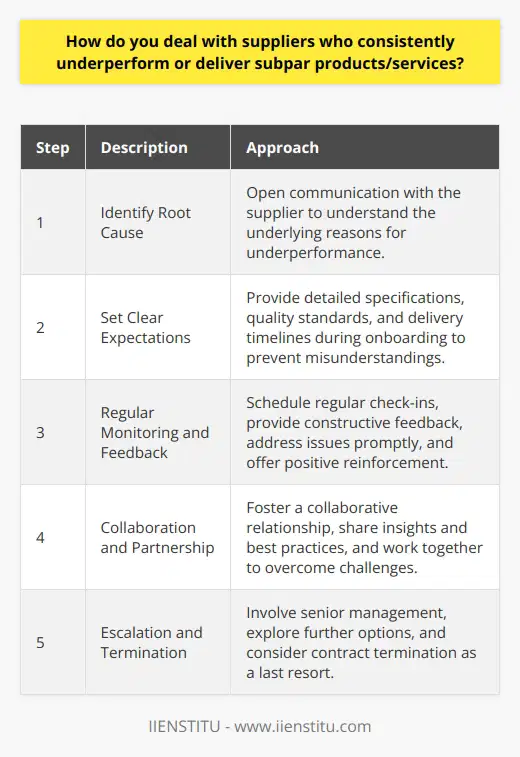
What is your process for addressing quality control issues with suppliers?
When addressing quality control issues with suppliers, I follow a structured process that ensures effective resolution. First, I gather all relevant information about the issue, including product specifications, quality standards, and customer feedback. This helps me understand the scope and severity of the problem.
Communication is Key
Next, I reach out to the supplier and schedule a meeting or call to discuss the issue. During the conversation, I clearly communicate our concerns and expectations, while also listening to their perspective. Together, we brainstorm potential solutions and agree on a plan of action.
Collaborative Problem-Solving
I believe in working collaboratively with suppliers to find mutually beneficial solutions. This may involve conducting joint quality audits, providing training and support, or implementing process improvements. Throughout the process, I maintain open lines of communication and provide regular updates to all stakeholders.
Continuous Improvement
Once the immediate issue is resolved, I work with the supplier to identify root causes and implement preventive measures. This may include updating quality control procedures, enhancing inspection protocols, or establishing more robust quality assurance systems. By continuously improving our processes, we can prevent similar issues from occurring in the future.
Building Strong Relationships
Throughout my career, I've learned that building strong relationships with suppliers is crucial for effective quality control. By fostering trust, transparency, and mutual respect, we can work together to deliver high-quality products and exceed customer expectations. I always strive to maintain positive, long-term partnerships with our suppliers.
In summary, my process for addressing quality control issues with suppliers involves gathering information, communicating effectively, collaborating on solutions, implementing continuous improvement measures, and building strong relationships. By following this approach, I've successfully resolved numerous quality issues and helped my company maintain a reputation for excellence.
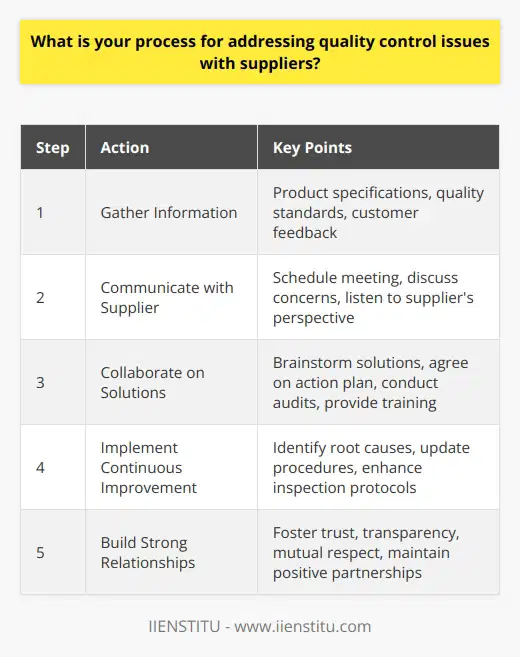
How do you manage relationships with suppliers located in different countries or time zones?
As a procurement manager, I've built strong relationships with suppliers across the globe. It's not always easy, but with the right approach, it can be incredibly rewarding.
Communication is Key
I make it a priority to maintain open lines of communication with all my suppliers. Whether it's through regular video calls, emails, or instant messaging, I ensure we're always on the same page. I've found that being proactive and responsive goes a long way in building trust and rapport.
Embrace Cultural Differences
When working with suppliers from different countries, it's important to be mindful of cultural nuances. I take the time to learn about their business practices, holidays, and communication styles. This helps me avoid misunderstandings and show respect for their culture.
Be Flexible with Scheduling
Time zone differences can be challenging, but I've learned to be flexible. I'm willing to take early morning or late evening calls to accommodate my suppliers' schedules. It's a small gesture that shows I value their time and effort.
Leverage Technology
Technology has been a game-changer in managing supplier relationships. I use project management tools to keep everyone aligned on deadlines and deliverables. Cloud-based platforms allow for easy document sharing and collaboration, no matter where we're located.
Foster Personal Connections
At the end of the day, business is about people. I make an effort to get to know my suppliers on a personal level. I remember birthdays, ask about their families, and share a bit about myself too. These personal touches help strengthen our working relationship and make it more enjoyable for everyone involved.
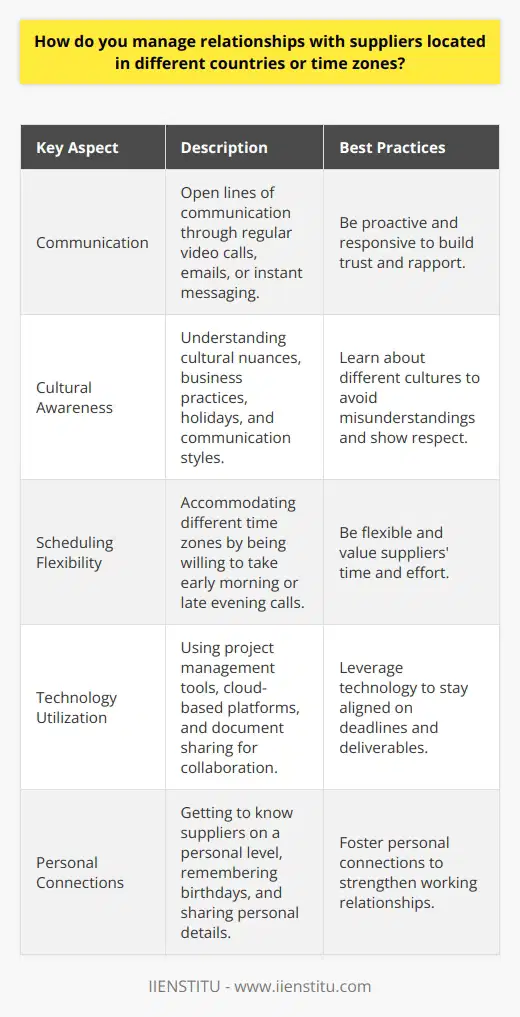
Can you describe a time when you had to terminate a contract with a supplier due to unresolved conflicts?
I once had to terminate a contract with a supplier due to persistent quality issues and communication breakdowns. Despite numerous attempts to resolve the problems, the supplier consistently failed to meet our standards and deadlines.
Identifying the Issues
I noticed a pattern of subpar deliveries and missed commitments from this particular supplier. Their products often arrived damaged or not meeting our specifications, causing delays in our production process.
Furthermore, the supplier was unresponsive to our inquiries and concerns. Emails and phone calls would go unanswered for days, leaving us in the dark about the status of our orders.
Attempting Resolution
I scheduled face-to-face meetings with the supplier's management team to address the issues head-on. We discussed the quality concerns and emphasized the importance of timely communication.
I provided clear examples of the problems we encountered and offered suggestions for improvement. We agreed on a corrective action plan and set measurable goals to track progress.
Making the Difficult Decision
Despite our best efforts, the supplier continued to fall short of expectations. I realized that continuing the relationship would jeopardize our own product quality and customer satisfaction.
After careful consideration and consultation with my team, I made the tough decision to terminate the contract. It was a challenging situation, but I knew it was necessary for the long-term success of our company.
Lessons Learned
This experience taught me the importance of setting clear expectations and maintaining open lines of communication with suppliers. It also highlighted the need for thorough due diligence when selecting partners.
Moving forward, I implemented more stringent supplier evaluation processes and regular performance reviews to prevent similar situations from occurring in the future.
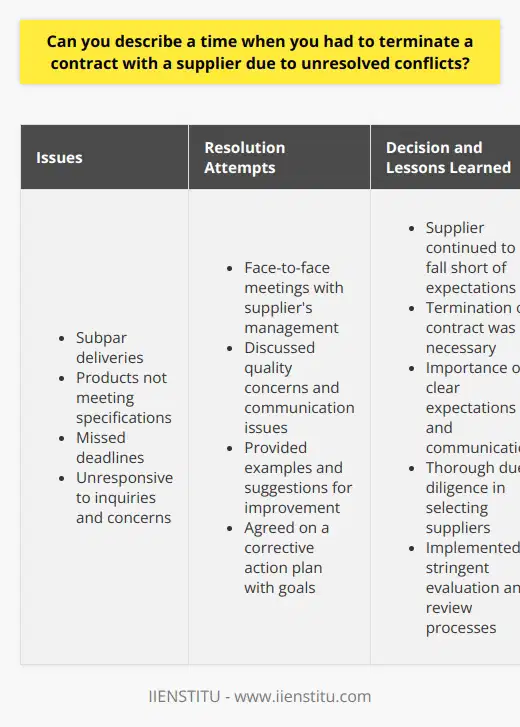
What techniques do you use to build trust and long-term partnerships with suppliers?
I believe that building trust and long-term partnerships with suppliers is crucial for any business's success. Here are some techniques I use to foster strong relationships:
Open Communication
I prioritize open and honest communication with suppliers. I share our company's goals, expectations, and challenges. This transparency helps build a foundation of trust and mutual understanding.
Regular Check-Ins
I schedule regular check-ins with suppliers to discuss progress, address concerns, and explore opportunities for improvement. Consistent communication keeps everyone on the same page and strengthens our partnership.
Collaborative Problem-Solving
When issues arise, I approach them with a collaborative mindset. I work closely with suppliers to find mutually beneficial solutions. By tackling challenges together, we deepen our trust and commitment to each other's success.
Shared Goals and Metrics
I align our company's objectives with those of our suppliers. We establish shared goals and metrics to measure our progress. This creates a sense of unity and shared responsibility for outcomes.
Recognition and Appreciation
I make a point to recognize and appreciate the efforts of our suppliers. Whether it's through public acknowledgment, performance bonuses, or simply expressing gratitude, showing appreciation fosters goodwill and strengthens our relationships.
By implementing these techniques consistently, I've been able to build trust and long-term partnerships with suppliers that have greatly contributed to our company's success. I'm confident that I can bring this same approach to this role and create valuable supplier relationships that drive results.
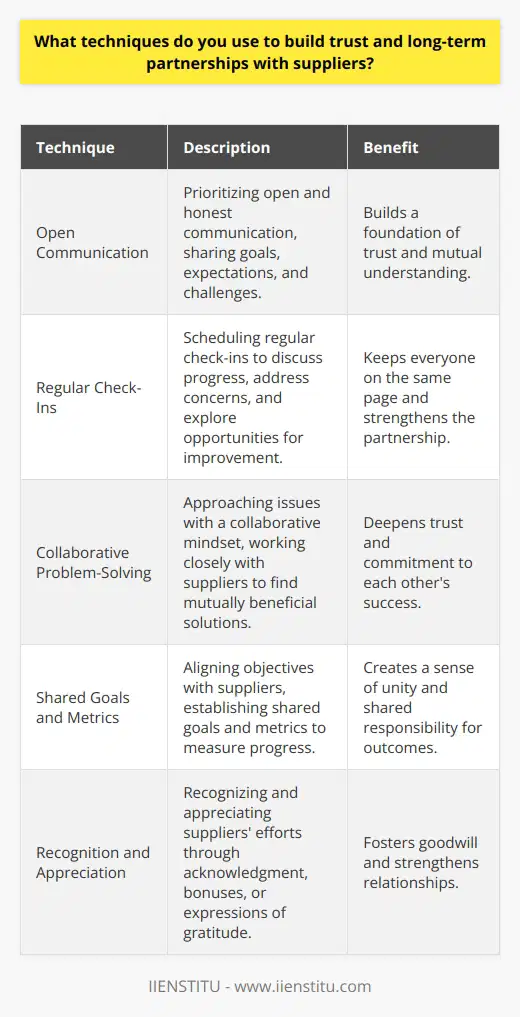
How do you handle price negotiations with suppliers during times of conflict?
When handling price negotiations with suppliers during times of conflict, I always strive to maintain strong relationships while achieving fair outcomes. This requires open and honest communication to understand each party's needs and constraints.
Finding Common Ground
I look for ways to find win-win solutions and common ground, even when there are disagreements. In my experience, most suppliers are reasonable if you treat them with respect and explain your position clearly. Whenever possible, I try to find creative alternatives that work for both sides, like discussing extended payment terms, adjusting order quantities, or exploring substitute materials. The key is working collaboratively with suppliers as partners to resolve issues.
Standing Firm When Needed
At the same time, I'm not afraid to stand firm and advocate strongly for my company's interests when truly needed. If a supplier's prices seem unwarranted, I'll push back and request detailed justification. But I aim to do this professionally and diplomatically to maintain the relationship. I recall one case where a supplier wanted to raise prices 25% mid-contract. After some tough but cordial negotiation, we settled on a reasonable 10% increase with the option to rebid the contract the following year.
In the end, I believe having strong supplier relationships and fair, collaborative resolutions to conflicts are both essential. This balanced approach has enabled me to consistently negotiate optimal outcomes in challenging circumstances throughout my career. I'm confident I can apply these same skills to add value and strengthen supplier partnerships here at [Company].
![When handling price negotiations with suppliers during times of conflict, I always strive to maintain strong relationships while achieving fair outcomes. This requires open and honest communication to understand each partys needs and constraints. Finding Common Ground I look for ways to find win-win solutions and common ground, even when there are disagreements. In my experience, most suppliers are reasonable if you treat them with respect and explain your position clearly. Whenever possible, I try to find creative alternatives that work for both sides, like discussing extended payment terms, adjusting order quantities, or exploring substitute materials. The key is working collaboratively with suppliers as partners to resolve issues. Standing Firm When Needed At the same time, Im not afraid to stand firm and advocate strongly for my companys interests when truly needed. If a suppliers prices seem unwarranted, Ill push back and request detailed justification. But I aim to do this professionally and diplomatically to maintain the relationship. I recall one case where a supplier wanted to raise prices 25% mid-contract. After some tough but cordial negotiation, we settled on a reasonable 10% increase with the option to rebid the contract the following year. In the end, I believe having strong supplier relationships and fair, collaborative resolutions to conflicts are both essential. This balanced approach has enabled me to consistently negotiate optimal outcomes in challenging circumstances throughout my career. Im confident I can apply these same skills to add value and strengthen supplier partnerships here at [Company].](https://img.iienstitu.com/assets/blog/en/handling-conflicts-with-supply-chain-suppliers/faqs/14/images/b3c1edbe360d6e87e6e4b152249d36a37bed2560.jpeg?v=2025-11-13&width=3840&quality=60&format=webp)
What is your approach to resolving conflicts that arise from cultural or language differences with suppliers?
When resolving conflicts that arise from cultural or language differences with suppliers, I prioritize open communication and mutual understanding. I believe active listening is crucial to grasp the root of the issue and the supplier's perspective.
Building Bridges
I strive to find common ground and build bridges between differing viewpoints. In one instance, a misunderstanding arose with an overseas supplier due to a cultural norm I was unaware of. Rather than making assumptions, I arranged a video call to discuss the matter openly and learn about their customs.
Seeking Solutions
Once I have a clear understanding of the conflict, I focus on finding mutually beneficial solutions. I aim to be respectful of cultural differences while still advocating for our company's needs and goals. Collaborating with the supplier to generate creative ideas is often the key to resolving issues.
Preventing Future Conflicts
I also believe in taking proactive steps to prevent cultural misunderstandings from occurring in the first place. I make an effort to research and educate myself about a supplier's culture, customs, and business practices. Building strong relationships based on trust and respect goes a long way in minimizing conflicts.
Continuous Learning
Resolving cultural conflicts is an ongoing learning process. I stay open-minded, willing to adapt my approach as needed. Each experience, whether challenging or successful, provides valuable lessons that enhance my ability to navigate cross-cultural supplier relationships effectively.
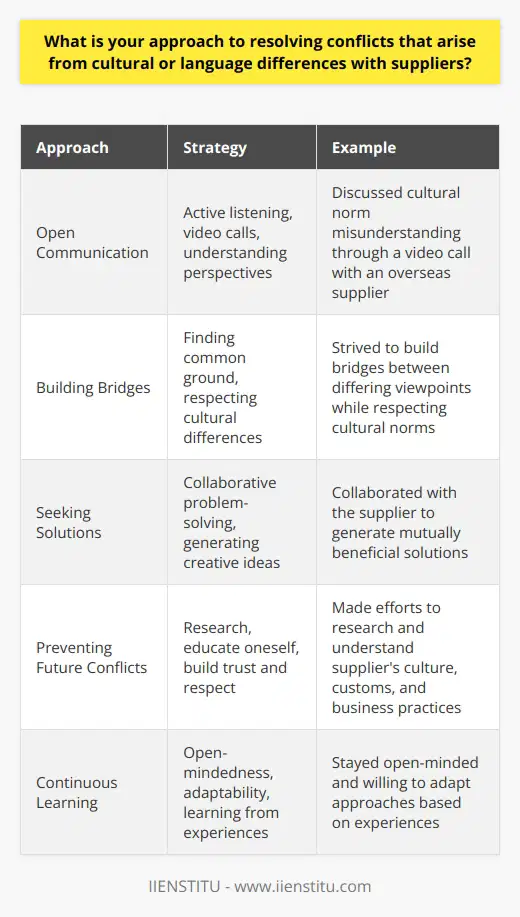
How do you ensure that suppliers adhere to your organization's ethical and sustainability standards?
At our organization, we take ethical and sustainability standards seriously when it comes to our suppliers. We have a rigorous vetting process in place to ensure that all suppliers align with our values and commitments.
Supplier Code of Conduct
We require all suppliers to sign and adhere to our Supplier Code of Conduct. This code outlines our expectations for ethical behavior, fair labor practices, environmental stewardship, and transparency. We regularly review and update this code to stay current with industry best practices and emerging issues.
Audits and Assessments
We conduct periodic audits and assessments of our suppliers' facilities and operations. These audits help us verify compliance with our standards and identify areas for improvement. We work collaboratively with suppliers to develop corrective action plans when needed.
Continuous Monitoring
We don't just rely on audits; we also engage in continuous monitoring of our suppliers. This includes regular check-ins, data tracking, and open communication channels. If we identify any red flags or concerns, we promptly investigate and address them.
Partnerships and Collaborations
We believe in the power of partnerships to drive positive change. We actively seek out suppliers who share our commitment to ethics and sustainability. We also participate in industry collaborations and initiatives to promote best practices and tackle systemic challenges.
Ultimately, ensuring ethical and sustainable practices in our supply chain is an ongoing process. It requires vigilance, collaboration, and a willingness to continuously improve. We're committed to this journey and to being a leader in responsible sourcing.

Can you give an example of how you used data or metrics to resolve a supply chain dispute?
In my previous role as a supply chain manager, I encountered a dispute between our company and a key supplier. The supplier claimed that we had not met our minimum order quantity, while our data showed that we had exceeded it by 20%.
Gathering the Data
To resolve the issue, I pulled together all the relevant data from our ERP system. I looked at our purchase orders, receipts, and inventory levels over the past six months. I also reviewed the terms of our contract with the supplier.
Analyzing the Metrics
After gathering the data, I spent time analyzing the key metrics. I calculated our average monthly order quantity, as well as the percentage variance from the minimum threshold. I also looked at our on-time delivery rates and quality metrics.
Presenting the Findings
Armed with this data, I scheduled a meeting with the supplier. I presented my findings in a clear and concise manner, using visualizations to support my points. I focused on the facts and avoided placing blame.
Reaching a Resolution
Through open and data-driven dialogue, we were able to reach a mutually beneficial resolution. We agreed to adjust our minimum order quantity going forward, based on the insights gleaned from the data. This experience taught me the power of using metrics to drive objective decision-making and defuse potentially contentious situations.
In the end, our relationship with the supplier was strengthened, and we were able to avoid costly litigation. I believe that my ability to leverage data and analytics was key to achieving this positive outcome.
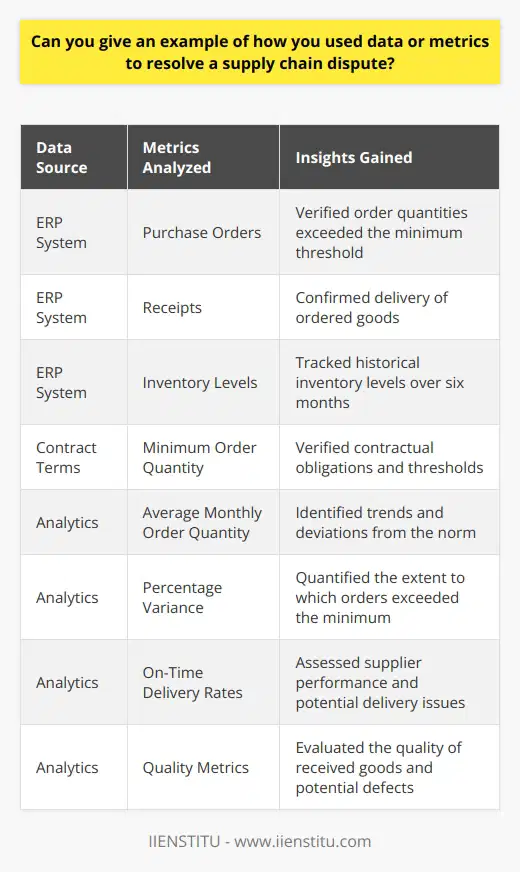
What steps do you take to minimize the impact of supplier conflicts on your organization's operations?
As a supply chain manager, I understand the importance of minimizing supplier conflicts to ensure smooth operations. Here are some steps I take to achieve this goal:
Building Strong Relationships
I believe in fostering open communication and trust with our suppliers. By regularly engaging with them, I can better understand their challenges and work together to find solutions. This collaborative approach helps prevent conflicts before they arise.
Diversifying Supplier Base
To reduce the risk of supply disruptions, I maintain a diverse network of suppliers. This way, if one supplier faces issues, I can quickly shift orders to another without significantly impacting our operations. It's a strategy that has proven effective in my experience.
Implementing Clear Contracts
I ensure that all supplier agreements include well-defined terms and conditions. By clearly outlining expectations, delivery schedules, and quality standards, I minimize the chances of misunderstandings that could lead to conflicts. It's a proactive approach that I've found invaluable.
Monitoring Supplier Performance
I closely track key metrics like on-time delivery and quality ratings for each supplier. If I notice any dips in performance, I promptly address the issue before it escalates. By catching potential problems early, I can work with the supplier to get things back on track.
Developing Contingency Plans
Despite best efforts, conflicts can still arise. That's why I create contingency plans for critical suppliers. By having backup options ready, I can swiftly respond to any disruptions and keep our operations running smoothly. It's a lesson I learned the hard way early in my career.
In my experience, these steps have been crucial in minimizing supplier conflicts and ensuring a resilient supply chain. I'm confident that I can bring this proactive approach to your organization and help optimize your operations.

How do you handle situations where a supplier's actions damage your company's reputation?
When a supplier's actions damage my company's reputation, I take immediate steps to address the situation. I believe in open and honest communication with our customers and stakeholders. Here are some key points I focus on:
Assess the Situation
First, I gather all the facts and assess the extent of the damage. I talk to my team and the supplier to understand what went wrong and why. It's important to get a clear picture before taking any action.
Communicate with Customers
Next, I reach out to our affected customers directly. I apologize for the inconvenience caused and assure them that we're working on a solution. Transparency is key here - I keep them updated on our progress and timeline for resolution.
Develop a Plan
Based on the assessment, I work with my team to develop a plan of action. This may involve finding an alternate supplier, offering compensation to customers, or implementing new quality control measures. The goal is to minimize further damage and prevent similar incidents in the future.
Hold the Supplier Accountable
I have a frank discussion with the supplier about the impact of their actions. Depending on the severity of the situation, we may need to terminate the relationship or put strict performance metrics in place. It's important to hold them accountable while also maintaining professionalism.
Learn and Improve
Finally, I believe in learning from every challenge. I conduct a post-mortem with my team to identify areas for improvement in our processes and vendor management. By continuously improving, we can build a more resilient and reputable company.
In summary, handling supplier-related reputational damage requires swift action, clear communication, and a focus on solutions. By being proactive and transparent, we can mitigate the impact and come out stronger as an organization.
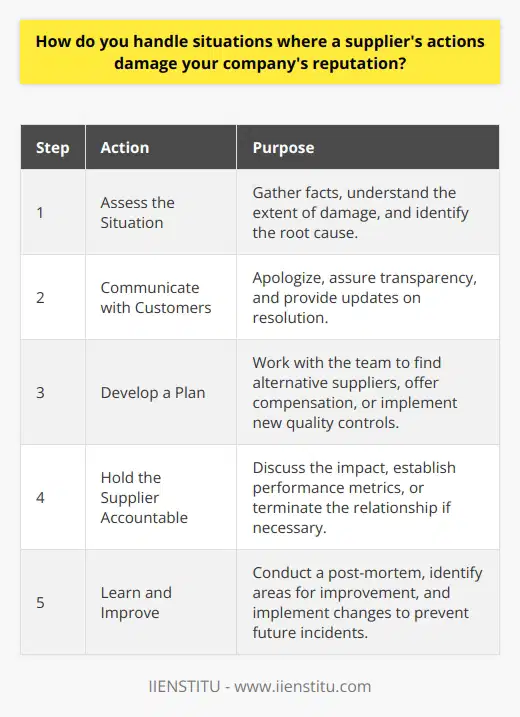
What is your process for conducting supplier audits to identify potential areas of conflict?
When conducting supplier audits, I follow a thorough process to identify potential areas of conflict. First, I review the supplier's documentation, including contracts, invoices, and quality reports. This helps me understand their operations and spot any discrepancies.
On-site Visits
Next, I arrange on-site visits to observe the supplier's facilities and processes firsthand. During these visits, I interview key personnel and assess their compliance with our standards. I also look for any red flags, such as unsafe working conditions or unethical practices.
Communication is Key
Throughout the audit process, I maintain open communication with the supplier. I ask questions, provide feedback, and work collaboratively to address any issues. By fostering a positive relationship, I can more effectively identify and resolve conflicts.
Detailed Reports
After each audit, I prepare a detailed report outlining my findings and recommendations. I highlight both strengths and areas for improvement, and provide specific action items for the supplier. I then follow up regularly to ensure that any necessary changes are implemented.
Continuous Improvement
Supplier audits are an ongoing process, not a one-time event. I continuously monitor supplier performance and conduct regular audits to identify potential conflicts early on. By staying proactive and engaged, I can help ensure that our suppliers meet our high standards for quality, safety, and integrity.
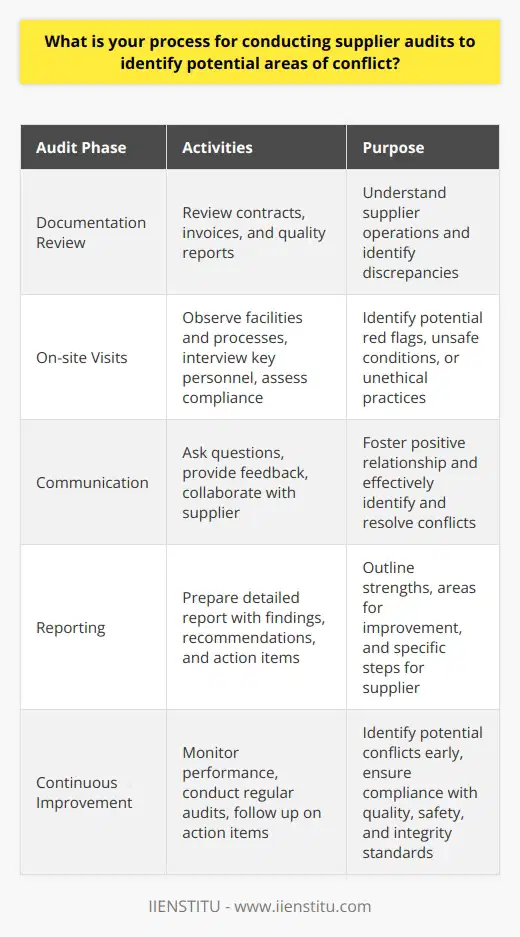
How do you balance the need to maintain supplier relationships with the need to protect your company's interests?
As a procurement specialist, I understand the importance of maintaining strong relationships with suppliers. These relationships are built on trust, open communication, and mutual respect. By fostering positive connections, we can ensure a reliable supply chain and favorable contract terms.
Protecting Company Interests
At the same time, I'm always mindful of protecting my company's best interests. This means thoroughly reviewing contracts, negotiating advantageous pricing and terms, and having contingency plans in place. I stay informed about market conditions and keep an eye out for potential risks or disruptions.
Finding the Right Balance
Balancing supplier relationships and company interests requires finesse and strategic thinking. I've found that being transparent about expectations, while also being fair and reasonable, goes a long way. When issues arise, I approach them with a problem-solving mindset, seeking win-win solutions whenever possible.
In one instance, a key supplier was struggling to meet our delivery deadlines due to unexpected challenges. Rather than immediately penalizing them, I worked closely with their team to find ways to streamline processes and get back on track. By showing empathy and collaborating to find a solution, we strengthened our partnership while still meeting our company's needs.
Continuous Evaluation and Improvement
I believe in regularly assessing supplier performance and having open dialogues about areas for improvement. This helps maintain accountability and ensures we're getting the best value for our investment. When necessary, I'm prepared to make tough decisions and explore alternative suppliers if it's in the best interest of the company.
Ultimately, finding the right balance comes down to building trust, being proactive, and always keeping the big picture in mind. By nurturing positive supplier relationships while staying vigilant about protecting our company, we can create a strong, resilient supply chain that supports our long-term success.
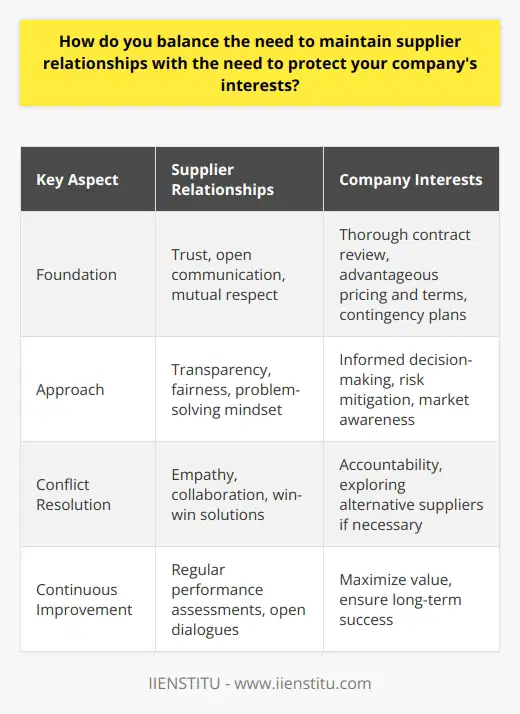
Can you describe a time when you had to mediate a conflict between two or more suppliers?
I once had to mediate a conflict between two suppliers who were both essential to our production process. The disagreement arose over a misunderstanding about delivery dates and product specifications.
Listening to Both Sides
I knew I had to act quickly to prevent the situation from escalating. I arranged a meeting with both suppliers and gave each of them the opportunity to express their concerns and perspectives.
I listened carefully, taking notes and asking clarifying questions. It was important to me that both parties felt heard and understood.
Finding Common Ground
As I listened, I realized that despite their differences, both suppliers shared a commitment to quality and timely delivery. I emphasized these shared values and goals, helping them see that they were on the same team.
I also pointed out how their continued partnership was mutually beneficial and essential to our company's success.
Proposing a Solution
After understanding both sides, I proposed a solution that addressed each supplier's key concerns. I suggested adjusting the delivery schedule and clarifying the product specifications in writing.
I also recommended setting up regular check-ins to ensure everyone stayed on the same page moving forward.
Reaching an Agreement
Both suppliers appreciated my efforts to understand their perspectives and find a fair resolution. They agreed to my proposed solution and committed to better communication in the future.
Through active listening, finding common ground, and proposing a mutually beneficial solution, I was able to successfully mediate the conflict and strengthen our supplier relationships.
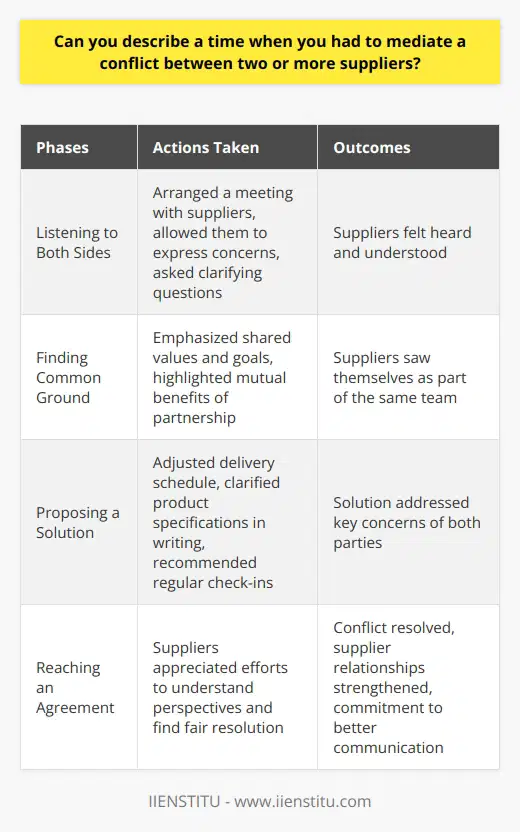
What methods do you use to ensure that suppliers deliver goods/services on time and within budget?
I have several methods to ensure suppliers deliver goods and services on time and within budget:
Building Strong Relationships
I invest time in getting to know my suppliers personally. We discuss their processes, challenges, and goals. This helps build trust and open communication, making it easier to address any issues that may arise.
Setting Clear Expectations
From the start, I clearly outline delivery timelines, quality standards, and pricing. I put agreements in writing and have both parties sign off. This prevents misunderstandings down the line.
Monitoring Progress
I schedule regular check-ins with suppliers to get status updates. If there are delays, we brainstorm solutions together. Consistent monitoring allows me to spot potential problems early before they snowball.
Having Backup Plans
While I aim to work with reliable suppliers, I always have a Plan B. I identify alternate vendors who can step in if needed. This reduces risk and keeps projects on track.
Incentivizing Performance
For larger contracts, I sometimes build incentives into the agreement. If suppliers deliver early or below budget, they earn a bonus. This motivates them to perform at their best.
By taking a proactive, relationship-driven approach, I've been able to consistently get timely, cost-effective results from suppliers. It takes effort, but it pays off in smoother operations and, ultimately, happier customers.
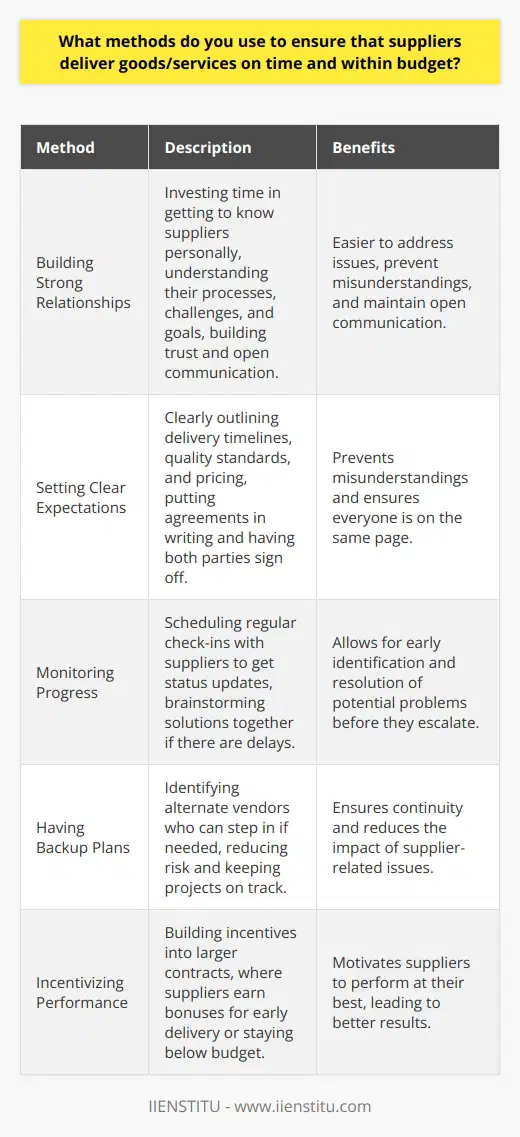
How do you handle situations where a supplier's financial instability threatens your supply chain?
When faced with a supplier's financial instability threatening our supply chain, I take a proactive and strategic approach. I believe in open communication and collaboration to find mutually beneficial solutions.
Assess the Situation
First, I gather all relevant information about the supplier's financial situation. I review their financial statements and credit reports. I also reach out to my contacts within the supplier's organization to get their perspective.
Develop Contingency Plans
Next, I work with my team to develop contingency plans. We identify alternative suppliers and assess their capacity and capabilities. We also look for ways to streamline our processes and reduce our dependence on the unstable supplier.
Example: Diversifying Our Supplier Base
In my previous role, we had a key supplier that was experiencing financial difficulties. I led the effort to diversify our supplier base. We identified three new suppliers and split our orders among them. This reduced our risk and ensured a stable supply chain.
Communicate with Stakeholders
Throughout the process, I keep all stakeholders informed. I provide regular updates to my manager and other departments impacted by the situation. I also maintain open lines of communication with the supplier, offering support where possible.
Monitor and Adjust
Finally, I closely monitor the situation and adjust our plans as needed. I track key metrics like on-time delivery and quality. If the supplier's performance improves, we may increase our orders. If it deteriorates, we may need to shift more business to alternative suppliers.
Handling a supplier's financial instability requires a calm, analytical approach. By assessing the situation, developing contingency plans, communicating with stakeholders, and monitoring progress, I work to mitigate risk and maintain a stable supply chain.
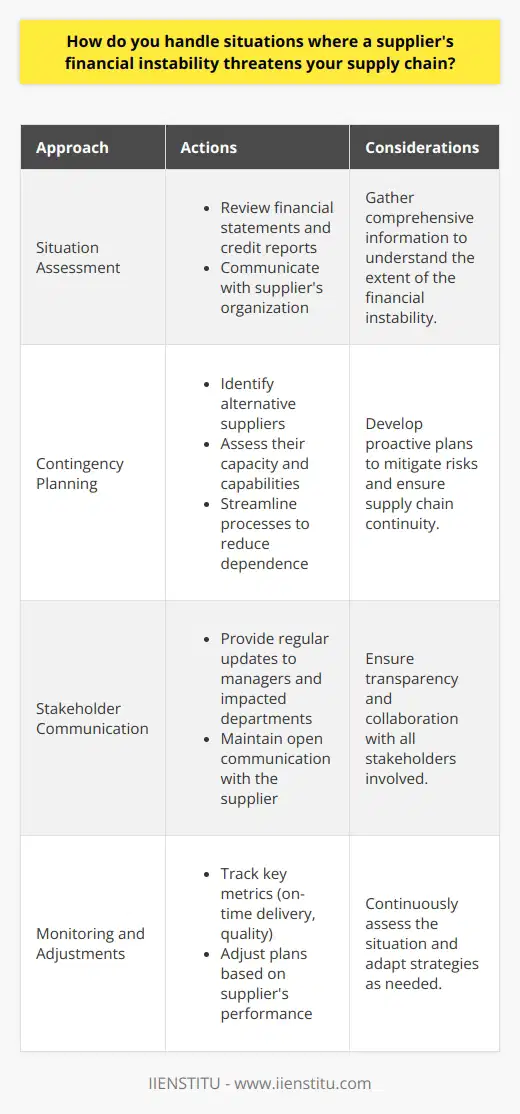
What is your approach to managing conflicts that arise from intellectual property or confidentiality issues with suppliers?
When it comes to managing conflicts related to intellectual property or confidentiality issues with suppliers, I believe in a proactive and collaborative approach. I've found that clear communication and setting expectations from the beginning is crucial.
Establishing Clear Contracts and Agreements
I always ensure that comprehensive contracts and non-disclosure agreements are in place before engaging with suppliers. These documents should outline the scope of the project, deliverables, timelines, and confidentiality obligations. By having a solid legal foundation, potential conflicts can be minimized.
Fostering Open Communication
I maintain open lines of communication with suppliers throughout the collaboration process. Regular check-ins and progress updates help identify any potential issues early on. If concerns arise, I address them promptly and work towards finding mutually beneficial solutions.
Protecting Confidential Information
Safeguarding confidential information is a top priority for me. I implement strict access controls and data security measures to prevent unauthorized disclosure. Only relevant team members are granted access to sensitive information on a need-to-know basis.
Seeking Legal Counsel When Necessary
In complex situations where conflicts escalate, I don't hesitate to seek guidance from legal experts. Their insights help navigate challenging circumstances and ensure compliance with applicable laws and regulations.
Overall, my approach centers around prevention, clear communication, and swift resolution when conflicts arise. By establishing trust, maintaining transparency, and prioritizing the protection of intellectual property and confidentiality, I strive to build strong, long-lasting relationships with suppliers while mitigating potential risks.
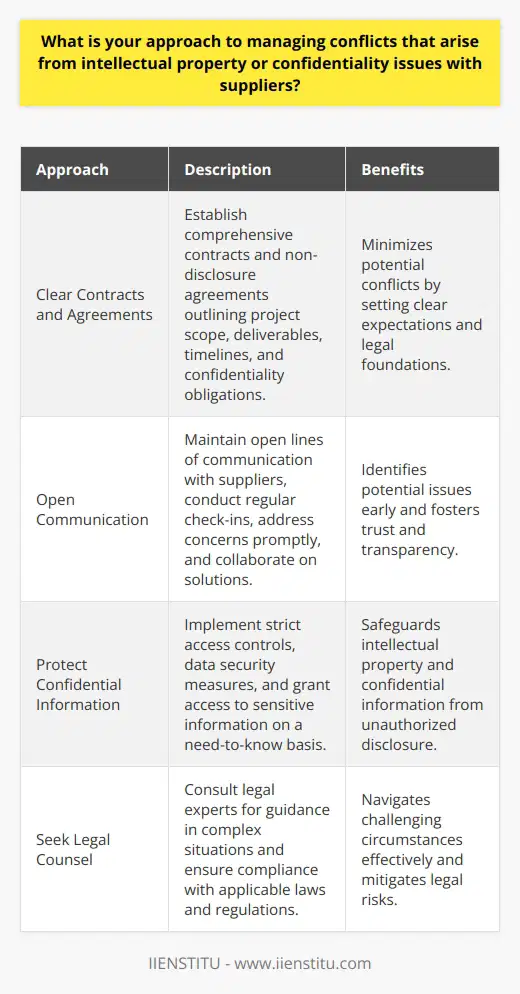
How do you ensure that suppliers comply with your organization's health and safety regulations?
As a purchasing manager, I take several steps to ensure suppliers comply with our health and safety regulations. First and foremost, I clearly communicate our expectations and requirements to all potential suppliers. This includes providing them with detailed documentation outlining our standards and procedures.
Rigorous Screening Process
Before entering into any agreements, I conduct thorough background checks and assessments of each supplier's track record. I look for red flags like past safety violations or accidents. Only suppliers who demonstrate a strong commitment to health and safety make it through this rigorous screening.
Regular Audits and Inspections
Once a supplier is approved, I don't just trust that they'll always meet our standards. I believe in "trust but verify." That's why I schedule regular on-site audits and inspections of their facilities. During these visits, I personally check that proper safety protocols are being followed.
Collaboration and Partnership
I've found that the best way to ensure compliance is through close collaboration with our suppliers. I strive to build positive relationships and treat them as valued partners. We work together to identify potential hazards and implement practical solutions. Open communication is key.
Swift Corrective Actions
If a supplier does fail to meet our health and safety requirements, I take swift action to remedy the situation. Depending on the severity, this could mean requiring additional training for their staff, imposing financial penalties, or in extreme cases, terminating the contract. The well-being of workers is always my top priority.
At the end of the day, I believe ensuring supplier compliance with health and safety is both a moral imperative and smart business. By holding our partners to high standards, we protect our company's reputation and create a safer world for everyone.
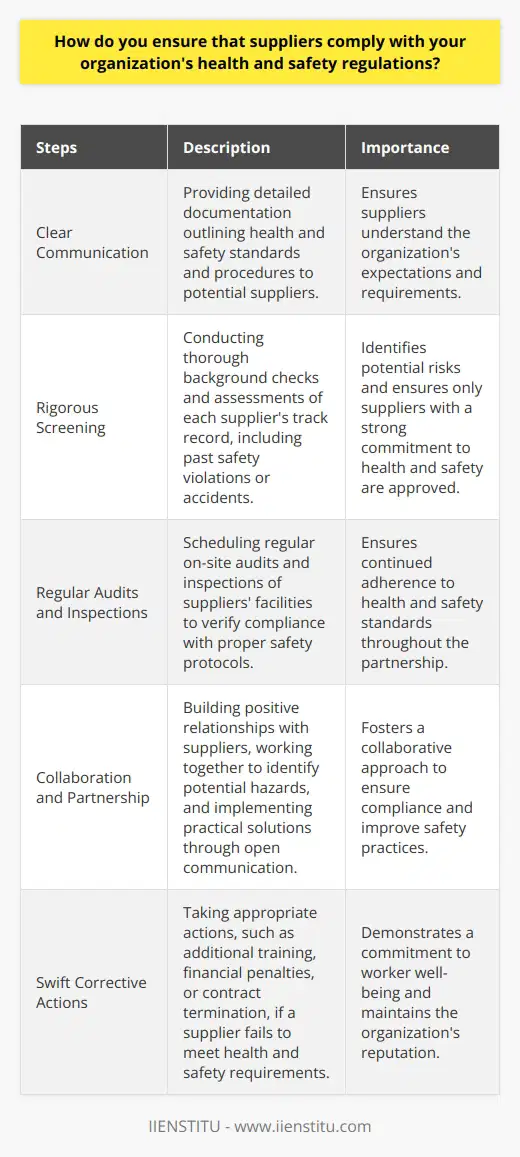
Can you give an example of how you used creative problem-solving to resolve a supply chain conflict?
In my previous role as a supply chain manager, I encountered a situation where a key supplier unexpectedly went bankrupt, leaving us without critical components for our production line. This could have been a disaster, but I quickly sprang into action.
Assessing the Situation
First, I gathered my team to assess the extent of the problem and brainstorm potential solutions. We identified which specific parts were affected and calculated how long our current inventory would last.
Reaching Out to Our Network
I reached out to my extensive network of contacts in the industry, asking if anyone had excess inventory of the needed components or knew of alternative suppliers. After many calls and emails, I located a company that could provide a suitable substitute, although at a higher price.
Negotiating a Solution
I negotiated with this new supplier to secure the best possible price and expedited shipping terms. It wasn't ideal, but it would allow us to keep production running while we searched for a longer-term solution.
Redesigning for the Future
Simultaneously, I worked with our engineering team to redesign our product to use more readily available components, reducing our vulnerability to future supply disruptions. It was a challenging few weeks, but through creative problem-solving and teamwork, we were able to overcome the crisis and emerge stronger.
Lessons Learned
This experience taught me the importance of building strong relationships, thinking outside the box, and always having contingency plans. I believe my ability to stay calm under pressure, communicate effectively, and find innovative solutions makes me well-suited to tackle the challenges of this role.
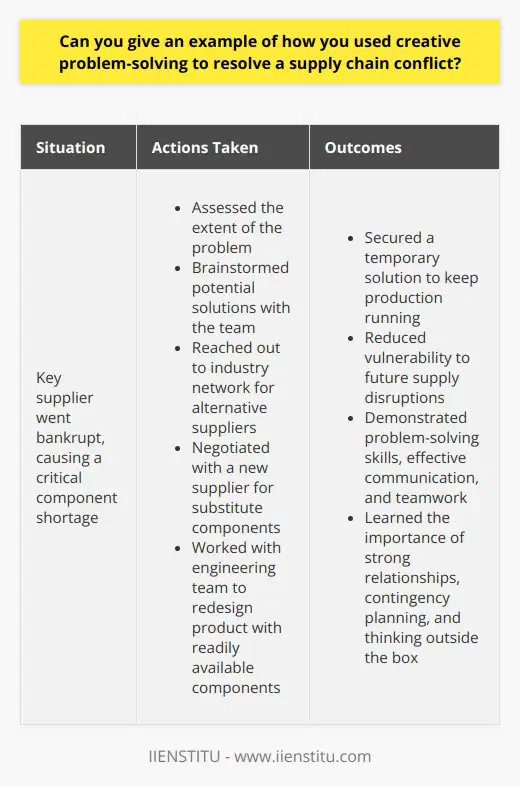
What steps do you take to maintain open lines of communication with suppliers during times of conflict?
I believe open communication is essential for maintaining strong supplier relationships, especially during times of conflict. I take a proactive approach to keep the lines of communication open and transparent.
Build Trust and Rapport
First, I focus on building trust and rapport with my suppliers from day one. I make an effort to get to know them personally, understand their business, and show genuine interest in their success. When conflicts arise, this foundation of trust helps us navigate challenges together.
Schedule Regular Check-Ins
I schedule regular check-in meetings or calls with key suppliers, even when things are going smoothly. This gives us dedicated time to discuss any potential issues, share updates, and brainstorm solutions. Consistency is key to staying connected and aligned.
Listen Actively and Empathize
During conflicts, I prioritize active listening and empathy. I seek to fully understand the supplier's perspective, concerns, and constraints. By putting myself in their shoes, I can better appreciate the situation and find mutually beneficial resolutions.
Collaborate on Problem-Solving
Rather than placing blame, I approach conflicts as opportunities for collaborative problem-solving. I involve suppliers in the process, soliciting their ideas and expertise. Together, we brainstorm creative solutions that address both of our needs and strengthen our partnership.
Maintain Professionalism and Respect
Even in challenging situations, I remain professional, respectful, and composed in all my supplier communications. I focus on the issues at hand rather than personal attacks. By maintaining a calm demeanor, I set the tone for productive dialogues.
Through these steps, I aim to cultivate open, honest, and constructive communication with suppliers, no matter the circumstances. By prioritizing transparency, empathy, and collaboration, I believe we can weather any conflicts and emerge with even stronger partnerships.
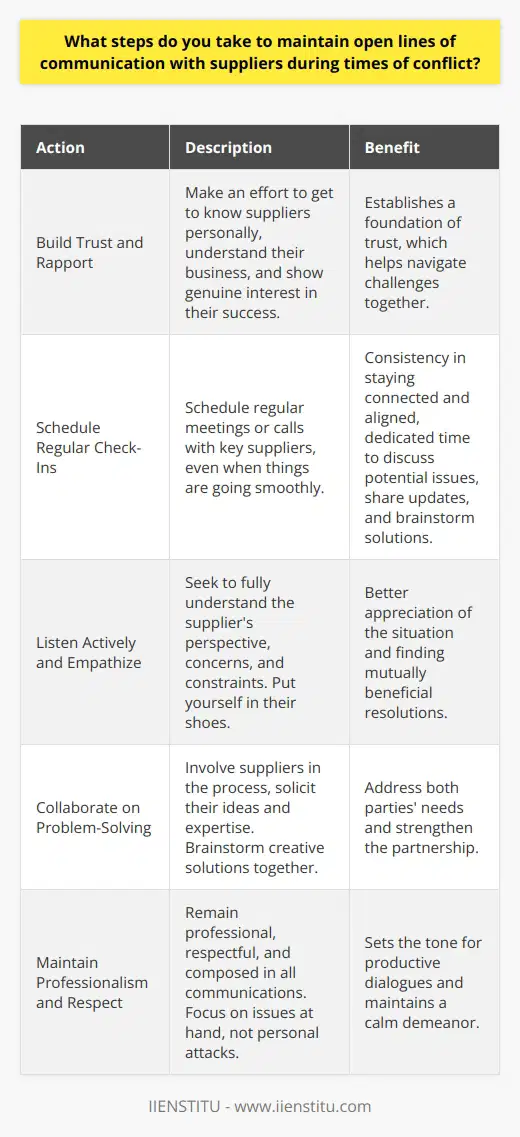
How do you handle situations where a supplier's actions violate your company's code of conduct?
When a supplier's actions violate our company's code of conduct, I believe in addressing the issue promptly and directly. I would first gather all the relevant facts and evidence to ensure a clear understanding of the situation. Next, I would reach out to the supplier to discuss the violation and express our concerns.
Seeking a Resolution
My goal would be to find a mutually agreeable solution that aligns with our company's values and standards. I would listen to the supplier's perspective and work collaboratively to identify the root cause of the problem. Together, we would develop a corrective action plan to prevent future violations and maintain a positive working relationship.
Escalating the Issue
If the supplier is unwilling to cooperate or the violation is severe, I would escalate the matter internally. I would involve the appropriate stakeholders, such as legal, compliance, and senior management, to determine the best course of action. This could include terminating the relationship with the supplier if necessary to protect our company's reputation and integrity.
Learning from the Experience
Regardless of the outcome, I believe in using these situations as learning opportunities for our organization. I would conduct a post-incident review to identify any gaps in our processes or communication that may have contributed to the violation. By continuously improving our systems and strengthening our partnerships, we can mitigate the risk of future incidents and ensure ethical conduct throughout our supply chain.
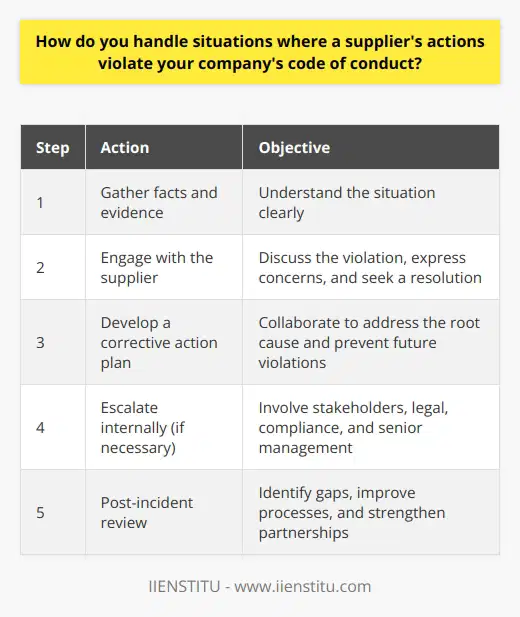
What is your process for reviewing and updating supplier contracts to minimize potential conflicts?
When reviewing and updating supplier contracts, I follow a systematic approach to minimize potential conflicts. First, I carefully read through the existing contracts, noting any areas that may be unclear or open to interpretation. I then compare the contracts to our current business needs and objectives, identifying any discrepancies or outdated terms.
Collaboration with Stakeholders
Next, I collaborate with key stakeholders, such as our legal team and department heads, to gather their input and concerns. This helps ensure that any proposed changes align with our overall strategy and risk management protocols. I also reach out to the suppliers themselves to discuss any issues and explore mutually beneficial solutions.
Negotiation and Conflict Resolution
When conflicts do arise, I approach them with a calm and professional demeanor. I actively listen to the supplier's perspective and work towards finding a fair compromise. I've found that open and honest communication is key to building strong, long-term partnerships.
Continuous Monitoring and Improvement
Finally, I believe in continuous monitoring and improvement. I regularly review supplier performance metrics and conduct periodic audits to ensure compliance with contract terms. If any issues are identified, I promptly address them and work with the supplier to implement corrective actions.
By following this proactive and collaborative approach, I've been able to successfully update supplier contracts while minimizing conflicts and strengthening our business relationships.
